Let’s talk about some of the most snake-infested rivers we can find in Arkansas. Now, “snake-infested rivers” is a strong turn of phrase. For many, it conjures up an image of a river chock-full of snakes with no room for any human being to go swimming in. However, this is not what we mean when we use the words “snake-infested”.
Although venomous snakebites are statistically rare, prompt medical treatment significantly increases the chances of survival for the vast majority of snake-bitten victims. Naturally, minimizing one’s encounters with snakes is key to reducing the risk of being bitten. However, in any areas where snakes can somehow find themselves next to you in a parallelling form of play and fun, it just might be best to take precautions to avoid them before that play becomes no fun.
In this article, we’ll go over three different rivers in Arkansas where you may run into the most snakes. These rivers are all located in the eastern and central parts of Arkansas, which are home to a variety of venomous snakes, including copperheads, cottonmouths, and rattlesnakes. This way, you can learn about some of these snake species that are in “the most snake-infested rivers” in Arkansas, and how to stay safe.
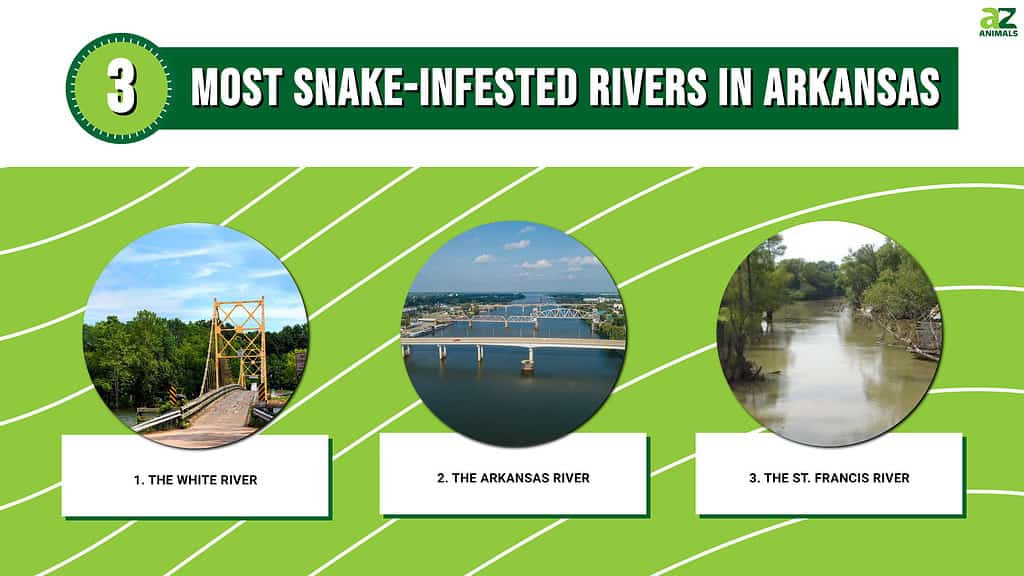
1. The White River
In the 1600s French explorers bestowed the name “La Rivière Blanche” upon the White River, as a result of the white sandbars lining its banks. The White River is one of the longest rivers in Arkansas and the 20th longest river in the whole of the United States. This river holds a prominent position among the beloved recreational spots in Arkansas. It also plays a vital role in boosting the state’s economy. The river supplies clean drinking water to millions of people and serves as a prominent tourist attraction, thus, actively contributing to Arkansas’ thriving economy.
However, in addition to the fish — and even snakes — swimming in its waters, the White River is home to something even more disturbing: the White River Monster. While the existence of this legendary being has never been conclusively proven, its story continues to captivate visitors as a prominent tourist attraction.
On the other hand, the snakes living in and around the White River are quite real, even though they are difficult to spot. The river is home to snakes like the copperhead and the cottonmouth, which are both venomous and dangerous. These snakes have great camouflage, so you’ll need to keep your eyes open and beware of your surroundings. They do not generally attack humans, but if they feel threatened (such as if a human steps on them), they can bite.
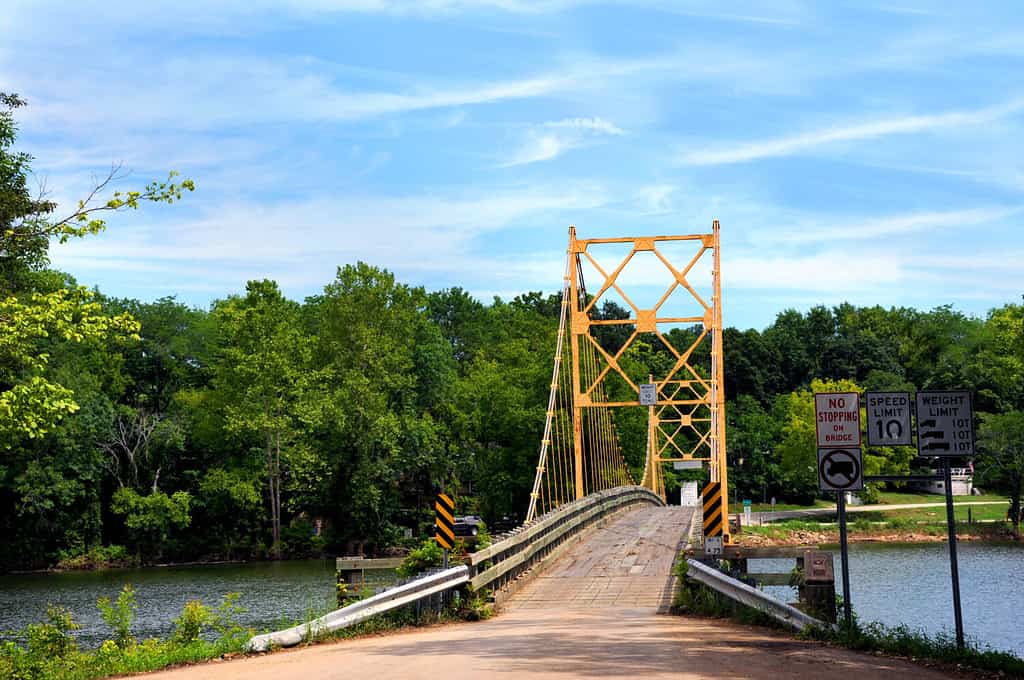
The White River flows through Arkansas from north to south.
©Bonita R. Cheshier/Shutterstock.com
2. The Arkansas River
The Arkansas River is another very long river in Arkansas, and it is also a major transportation route. It is home to a wide variety of wildlife, including reptiles, amphibians, fish, and birds. Many species of flora can also live in the river’s watersheds.
A significant tributary of the Mississippi River, the Arkansas River weaves through four states: Colorado, Kansas, Oklahoma, and Arkansas. In Arkansas, the river covers roughly 365 miles, streaming from the Oklahoma border to its union with the Mississippi River. The Arkansas River plays a pivotal role in the state’s economy. It serves as a source of irrigation, transportation, and recreation opportunities. It is also a vital resource for the people of Arkansas, providing drinking water, irrigation, and power.
The Arkansas River is also a popular destination for fishing, kayaking, whitewater rafting, hiking, and other amazing outdoor activities. If you visit, however, just remember to watch out for those snake-infested waters! There are so many different types of snakes living in and around the river, including venomous snakes like copperheads, rattlesnakes, cottonmouths, and coral snakes. There are also many nonvenomous snakes here, like plain-bellied water snakes, green water snakes, and Graham’s crayfish snakes.

Aerial photo of bridges over the Arkansas River, Little Rock, Arkansas.
©iStock.com/felixmizioznikov
3. The St. Francis River
The St. Francis River is another long river in Arkansas, and it is a popular destination for fishing and camping. It is home to a wide variety of fish and wildlife, including bass, catfish, sunfish, crappie, waterfowl, and of course, snakes! The river flows through predominantly rural landscapes, serving as a natural boundary along the western side of the Missouri Bootheel, marking the Missouri-Arkansas state line.
The St. Francis River plays a vital role in bolstering the Arkansas economy. A crucial water source for irrigation and drinking purposes, it additionally serves as a prominent transportation artery for both goods and people. This scenic riverbed also supports a variety of thriving industries, encompassing agriculture, forestry, and tourism.
The St. Francis River also brings in fishing enthusiasts, boaters, and campers from far and wide with its allure. The river offers public access points and the convenience of guided fishing trips and boat tours provided by outfitters. Immerse yourself in the beauty of nature as you encounter a diverse array of wildlife, from graceful deer and majestic turkey to awe-inspiring bald eagles. Just be sure to have fun safely, without getting bitten by any of the snakes living around the lake! There are both venomous and nonvenomous snakes living in and around St. Francis River, like copperheads and cottonmouths, as well as water snakes and hognose snakes.

The river offers public access points and the convenience of guided fishing trips and boat tours provided by outfitters.
Tips For Avoiding Snake Bites in the Most Snake-Infested Rivers in Arkansas
When exploring snake territory, it’s of utmost importance to stay alert and conscious of their presence. Be well-informed and vigilant during your outdoor escapades to ensure a pleasant and secure experience. Here are some valuable snake bite prevention techniques and practices to assist you on your journey:
- When venturing on a hike or camping expedition, it is wise to don sturdy boots and opt for long pants as a precautionary measure. This provides an added layer of protection, safeguarding your legs against the potential danger of snake bites.
- Exercise caution and thoroughly examine your surroundings for any signs of snakes before sitting or stepping on unfamiliar objects. Take care to make noise as you walk, which will alert snakes to your presence. Remain vigilant at all times to ensure your safety. Many snake bites occur because someone accidentally stepped on a hidden snake!
- It is highly advisable to refrain from interacting with wild snakes, regardless of whether they are venomous. It is always in your best interest to maintain a safe distance and avoid disturbing them, even if you perceive no immediate danger. In other words, it is crucial to exercise caution and avoid handling wild snakes, even if they appear lifeless.
- Steer clear of snake habitats, like tall grass, brush piles, and rock crevices. Choosing snake-free areas ensures safety and peace of mind while exploring nature.
Some Venomous Snakes Living In and Around the Most Snake-Infested Lakes in Arkansas
Timber Rattlesnake
With lengths typically ranging from 24 to 36 inches, timber rattlesnakes (Crotalus horridus) exhibit a color palette of gray or brown adorned with dark brown V-shaped markings. The tail displays a striking black hue, and has been the inspiration behind the nickname “velvet-tail rattler”.
Timber Rattlesnakes are diurnal and nocturnal creatures frequently spotted sunning themselves on rocks or logs. As ambush predators, they tend to strike their prey from the rear. Their venom is hemotoxic, causing damage to blood vessels and tissues.
Although they can cause a lot of damage, timber rattlesnakes are generally docile and shy creatures and will only resort to biting when they perceive a threat. They often also exhibit a unique warning mechanism by shaking their tails to caution potential predators. Immediate medical attention is crucial if bitten by a timber rattlesnake.
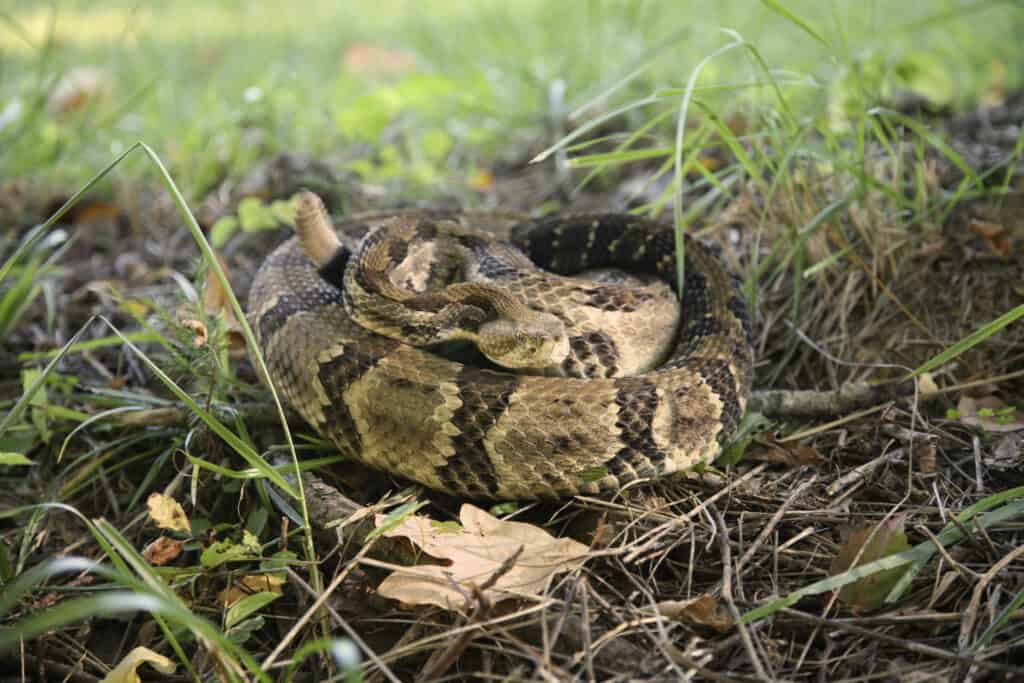
Timber Rattlesnakes are extremely venomous. However, they are not typically aggressive.
©iStock.com/NajaShots
Northern Cottonmouth Snake
The northern cottonmouth (Agkistrodon piscivorus) is a venomous snake that flourishes in a wide range of habitats, including rivers, streams, swamps, and marshes. Often known as the “water moccasin,” this fascinating species is readily recognized by its unmistakable white mouth, which it prominently exhibits in reaction to potential dangers. The northern cottonmouth is active during the day as well as at night. Despite its intimidating appearance, it prefers to flee than fight if given the chance. Of course, you should always treat this species with caution due to its venomous bite.
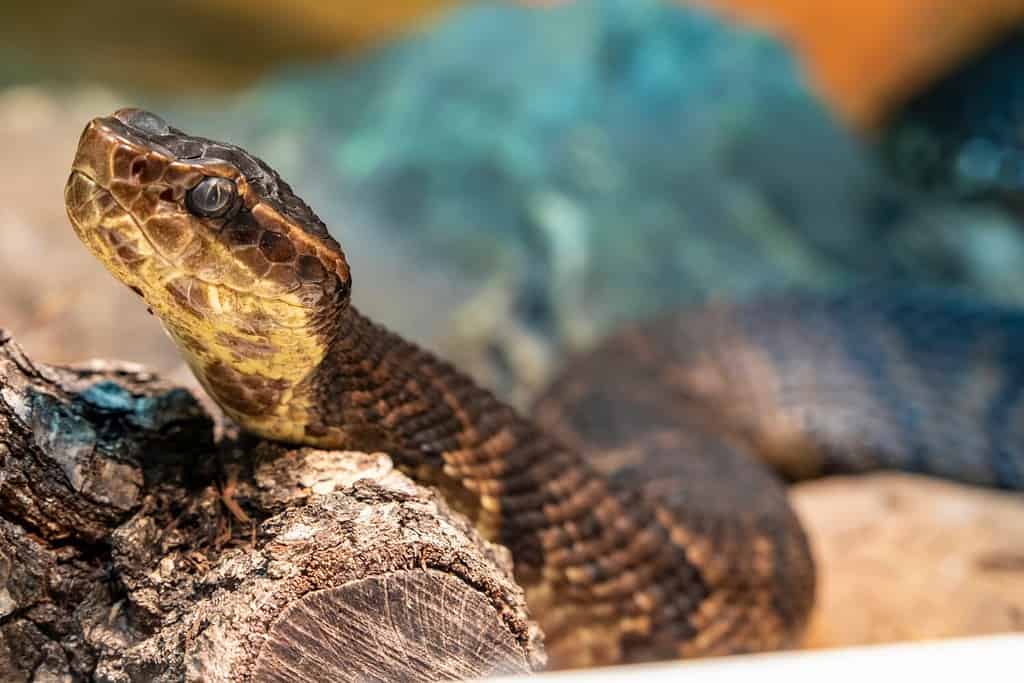
The northern cottonmouth is a semiaquatic viper native to the southeastern United States.
©Danny Ye/Shutterstock.com
Copperhead Snake
The copperhead snake (Agkistrodon contortrix) is a venomous reptile native to the eastern United States and prominently found in Arkansas. It holds the title of being the most abundant venomous snake in Arkansas. Copperheads live in diverse habitats, ranging from forests and fields to even urban areas. These cunning serpents are masters of stealth, equally active in daylight and darkness. Employing the art of ambush, they patiently lie in wait for unsuspecting prey such as rodents, frogs, and lizards, expertly striking when the perfect opportunity arises.
Copperheads generally measure between 24-36 inches in length, although certain individuals can reach up to 48 inches. Their body displays a captivating coppery-brown hue adorned with deeper brown hourglass-shaped markings.
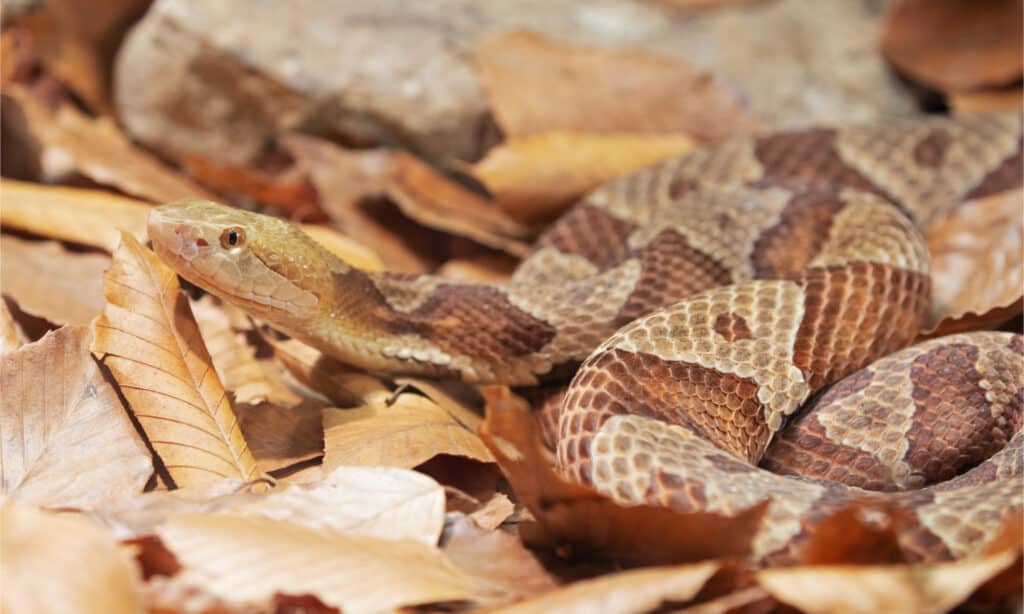
Copperhead snakes are masters of camouflage and can be easily stepped on if you’re not paying close attention to your surroundings!
©DnDavis/Shutterstock.com
Western Diamondback Rattlesnake
The Western diamondback rattlesnake (Crotalus atrox) is a venomous snake in the western and central parts of Arkansas. It is a large species, growing up to 4 feet in length, and its back is marked with a diamond pattern of light and dark brown or grayish-brown diamonds, with the same color on its sides and belly. The western diamondback is a venomous snake, and its bites can be very dangerous if not treated properly. It is important to give this snake plenty of space when encountered in the wild.
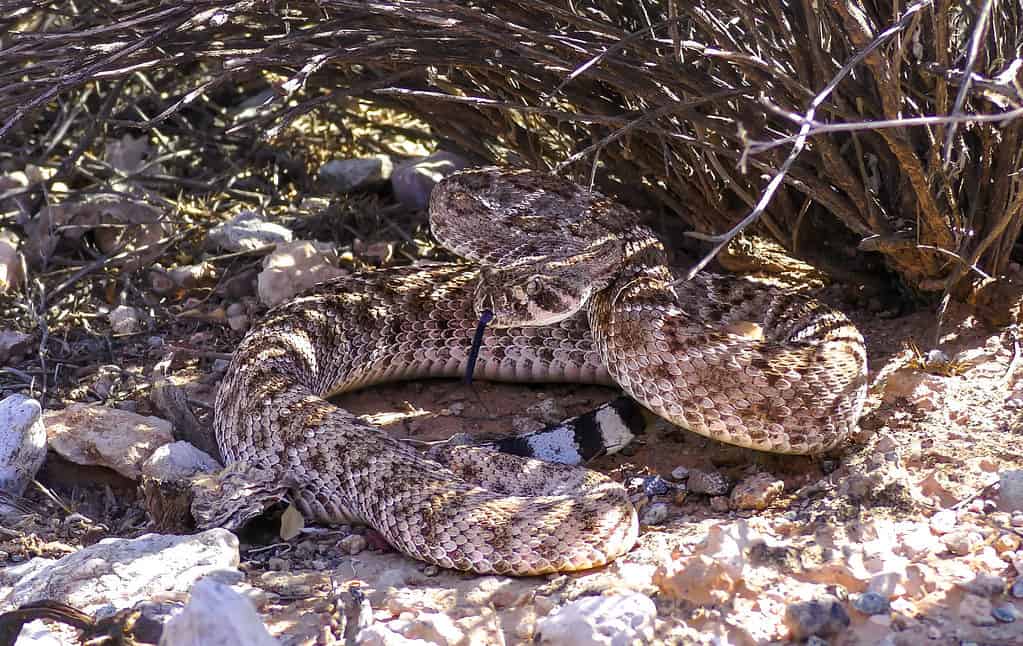
Western diamondback rattlesnakes are the largest venomous snakes in Arkansas.
©iStock.com/Banu R
Texas Gulf-Coast Coral Snake
The Texas Gulf Coast coral snake (Micrurus tener) is a venomous serpent native to the southern regions of Arkansas. This particular snake species is relatively small in size, typically reaching a length of approximately 24 inches. What sets the Texas Gulf Coast coral snake apart is its unmistakable coloration, characterized by alternating bands of black, red, and yellow. The vibrant red bands are notably wider than the black ones, while the yellow bands tend to be narrower. As for its habitat preferences, the Texas Gulf Coast coral snake can be found dwelling in a diverse array of environments, including forests, fields, and areas adjacent to bodies of water.

Due to its elusive nature, Texas Gulf-Coast coral snakes tend to be extremely secretive and rarely spotted by human observers.
©1125089601/Shutterstock.com
Some Nonvenomous Snakes Living In and Around the Most Snake-Infested Lakes in Arkansas
Plain-Bellied Water Snake
The plain-bellied water snake (Nerodia erythrogaster) is a nonvenomous snake that inhabits various regions across the eastern United States, including Arkansas. Although it doesn’t have venom, water snakes can be aggressive and readily bite.
The plain-bellied water snake is a medium-sized serpent, usually measuring between 24 and 36 inches in length. The dorsal coloration of its body is highly variable, ranging from shades of brown, and gray, to olive. Conversely, the belly adorns a smooth yet vibrant hue of yellow or cream. The younger specimens exhibit a captivating pattern of dark brown or black blotches on their back, which gradually diminishes as they mature.

Plain-bellied water snakes are excellent swimmers and are often spotted swimming along the surface of the water.
©iStock.com/lbolton09
Green Water Snake
Another nonvenomous water snake, the green water snake (Nerodia cyclopion) lives in different types of aquatic habitats like rivers, streams, marshes, and swamps. Its body is colored with shades of olive, green, or brown, with scales that reflect the light uniquely. Juvenile snakes have distinctly dark, alternating markings on their back and sides. However, as they age these markings gradually fade, and adults are typically solid in color.

The green water snake is found only in the southeastern United States.
©Jason Patrick Ross/Shutterstock.com
Graham’s Crayfish Snake
Graham’s crayfish snake (Regina grahamii) is a charming nonvenomous serpent that thrives in a diverse range of habitats. Whether it be the lush forests, sprawling fields, or the proximity of water bodies, this adaptable species can be found dwelling in various environments. Adorned with a delightful color palette, Graham’s crayfish snakes typically showcase hues of brown or tan, complemented by a striking black stripe running down the center of their back. In terms of size, these serpents are relatively petite, usually measuring around 12 inches in length.
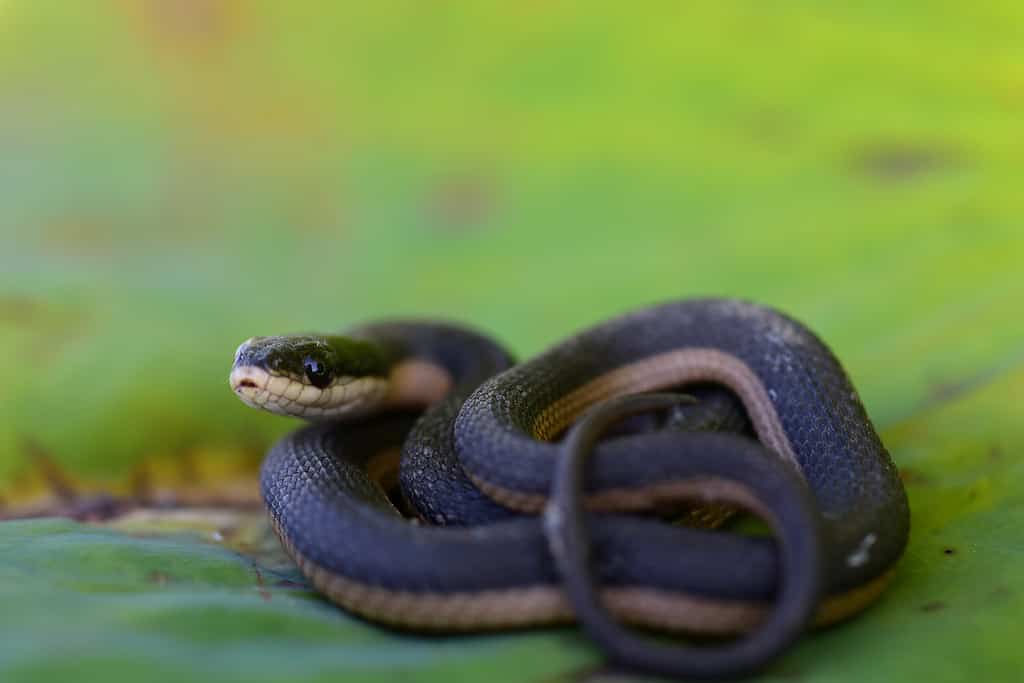
Graham’s crayfish snake is a semi-aquatic species that is harmless to humans.
©Rusty Dodson/Shutterstock.com
Eastern Hognose Snake
From the enchanting depths of forests to the expansive landscapes of fields, and even near the tranquil allure of water, the eastern hognose snake (Heterodon platirhinos) is an adaptable species that takes residence in diverse environments. Adorned with a captivating color palette, the eastern hognose snake typically exhibits shades of brown or gray, accentuated by a commanding black stripe that gracefully extends along the length of its back. When it comes to size, these serpents are relatively small, reaching an average length of approximately 24 inches.
Unfortunately, due to their appearance, eastern hognose snakes are often victims of mistaken identity, with many people killing or hurting them. However, these incredible snakes are completely harmless to humans and should be given space and respect whenever spotted in Arkansas.
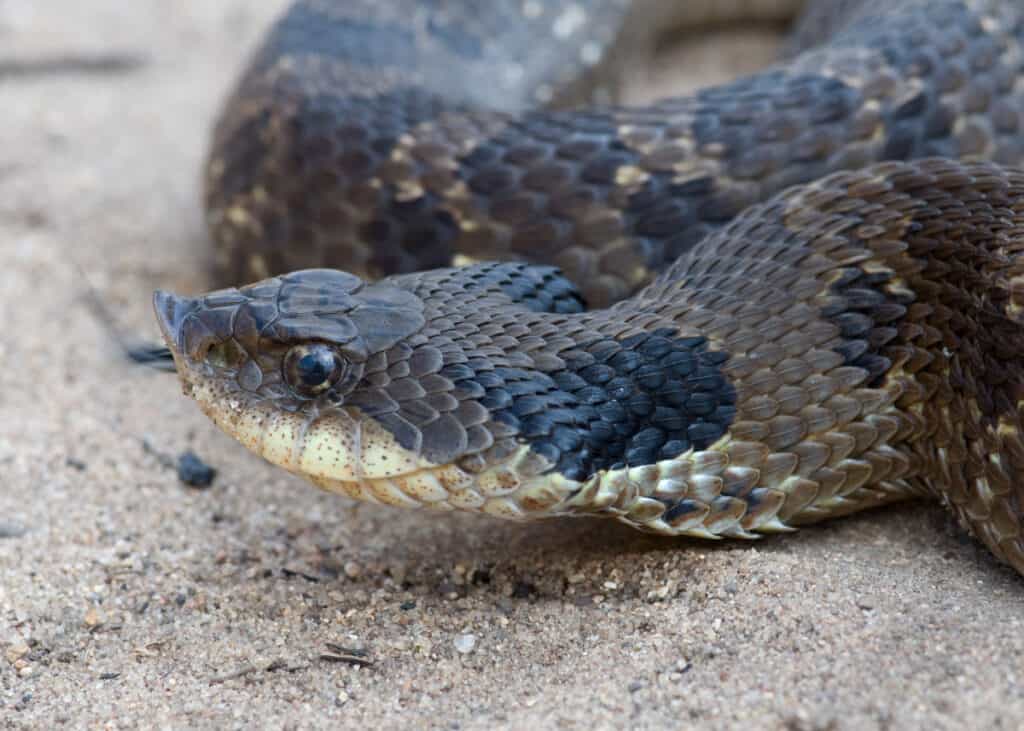
Eastern hognose snakes come in many different colors, but they all have wide heads and necks that appear flattened.
©Gerald A. DeBoer/Shutterstock.com
Summary of The 3 Most Snake-Infested Rivers in Arkansas
| Rank | River | Source |
|---|---|---|
| 1 | White River | Boston Mountains |
| 2 | Arkansas River | Confluence of East Fork Arkansas River and Tennessee Creek |
| 3 | St. Francis River | Elephant Rocks State Park |
The photo featured at the top of this post is © nishav/Shutterstock.com
Thank you for reading! Have some feedback for us? Contact the AZ Animals editorial team.







